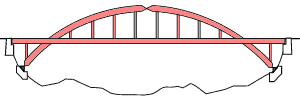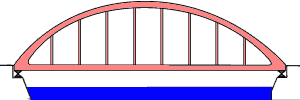inspirations
Arch
After girders, arches are the second oldest bridge type and a classic structure. Unlike simple girder bridges, arches are well suited to the use of stone. Many ancient and well know examples of stone arches still stand to this day. Arches are good choices for crossing valleys and rivers since the arch doesn't require piers in the center. Arches can be one of the more beautiful bridge types.
Arches use a curved structure which provides a high resistance to bending forces. Unlike girder and truss bridges, both ends of an arch are fixed in the horizontal direction (i.e. no horizontal movement is allowed in the bearing). Thus when a load is placed on the bridge (e.g. a car passes over it) horizontal forces occur in the bearings of the arch. These horizontal forces are unique to the arch and as a result arches can only be used where the ground or foundation is solid and stable.

The three-hinged arch adds an additional hinge at the top or crown of the arch. The three-hinged arch suffers very little if there is movement in either foundation (due to earthquakes, sinking, etc.) However, the three-hinged arch experiences much more deflection and the hinges are complex and can be difficult to fabricate. The three-hinged arch is rarely used anymore.

The tied arch is a variation on the arch which allows construction even if the ground is not solid enough to deal with the horizontal forces. Rather than relying on the foundation to restrain the horizontal forces, the girder itself "ties" both ends of the arch together.



